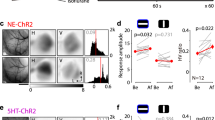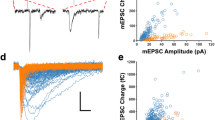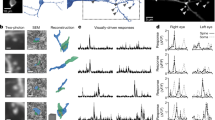Abstract
A dramatic form of experience-dependent synaptic plasticity is revealed in visual cortex when one eye is temporarily deprived of vision during early postnatal life. Monocular deprivation (MD) alters synaptic transmission such that cortical neurons cease to respond to stimulation of the deprived eye, but how this occurs is poorly understood. Here we show in rat visual cortex that brief MD sets in motion the same molecular and functional changes as the experimental model of homosynaptic long-term depression (LTD), and that prior synaptic depression by MD occludes subsequent induction of LTD. The mechanisms of LTD, about which there is now a detailed understanding, therefore contribute to visual cortical plasticity.
This is a preview of subscription content, access via your institution
Access options
Subscribe to this journal
Receive 12 print issues and online access
$209.00 per year
only $17.42 per issue
Buy this article
- Purchase on Springer Link
- Instant access to full article PDF
Prices may be subject to local taxes which are calculated during checkout







Similar content being viewed by others
References
Wiesel, T.N. Postnatal development of the visual cortex and the influence of the environment. Nature 299, 583–592 (1982).
Mioche, L. & Singer, W. Chronic recordings from single sites of kitten striate cortex during experience-dependent modifications of receptive-field properties. J. Neurophysiol. 62, 185–197 (1989).
Rittenhouse, C.D., Shouval, H.Z., Paradiso, M.A. & Bear, M.F. Monocular deprivation induces homosynaptic long-term depression in visual cortex. Nature 397, 347–350 (1999).
Bear, M.F., Cooper, L.N. & Ebner, F.F. A physiological basis for a theory of synaptic modification. Science 237, 42–48 (1987).
Dudek, S.M. & Bear, M.F. Homosynaptic long-term depression in area CA1 of hippocampus and effects of N-methyl-D-aspartate receptor blockade. Proc. Natl. Acad. Sci. USA 89, 4363–4367 (1992).
Mulkey, R.M., Endo, S., Shenolikar, S. & Malenka, R.C. Calcineurin and inhibitor-1 are components of a protein-phosphatase cascade mediating hippocampal LTD. Nature 369, 486–488 (1994).
Kirkwood, A. & Bear, M.F. Homosynaptic long-term depression in the visual cortex. J. Neurosci. 14, 3404–3412 (1994).
Kandler, K., Katz, L.C. & Kauer, J.A. Focal photolysis of caged glutamate produces long-term depression of hippocampal glutamate receptors. Nat Neurosci 1, 119–123 (1998).
Dodt, H., Eder, M., Frick, A. & Zieglgansberger, W. Precisely localized LTD in the neocortex revealed by infrared-guided laser stimulation. Science 286, 110–113 (1999).
Edelman, G.M. & Gally, J.A. Degeneracy and complexity in biological systems. Proc. Natl. Acad. Sci. USA 98, 13763–13768 (2001).
Barria, A., Muller, D., Derkach, V., Griffith, L.C. & Soderling, T.R. Regulatory phosphorylation of AMPA-type glutamate receptors by CaM-KII during long-term potentiation. Science 276, 2042–2045 (1997).
Lee, H.K., Kameyama, K., Huganir, R.L. & Bear, M.F. NMDA induces long-term synaptic depression and dephosphorylation of the GluR1 subunit of AMPA receptors in hippocampus. Neuron 21, 1151–1162 (1998).
Lee, H.K., Barbarosie, M., Kameyama, K., Bear, M.F. & Huganir, R.L. Regulation of distinct AMPA receptor phosphorylation sites during bidirectional synaptic plasticity. Nature 405, 955–959 (2000).
Kim, C.H., Chung, H.J., Lee, H.K. & Huganir, R.L. Interaction of the AMPA receptor subunit GluR2/3 with PDZ domains regulates hippocampal long-term depression. Proc. Natl. Acad. Sci. USA 98, 11725–11730 (2001).
Banke, T.G. et al. Control of GluR1 AMPA receptor function by cAMP-dependent protein kinase. J. Neurosci. 20, 89–102 (2000).
Malinow, R. & Malenka, R.C. AMPA receptor trafficking and synaptic plasticity. Annu. Rev. Neurosci. 25, 103–126 (2002).
Ehlers, M.D. Reinsertion or degradation of AMPA receptors determined by activity- dependent endocytic sorting. Neuron 28, 511–525 (2000).
Chung, H.J., Xia, J., Scannevin, R.H., Zhang, X. & Huganir, R.L. Phosphorylation of the AMPA receptor subunit GluR2 differentially regulates its interaction with PDZ domain-containing proteins. J. Neurosci. 20, 7258–7267 (2000).
Heynen, A.J., Abraham, W.C. & Bear, M.F. Bidirectional modification of CA1 synapses in the adult hippocampus in vivo. Nature 381, 163–166 (1996).
Kameyama, K., Lee, H.K., Bear, M.F. & Huganir, R.L. Involvement of a postsynaptic protein kinase A substrate in the expression of homosynaptic long-term depression. Neuron 21, 1163–1175 (1998).
Malenka, R.C. & Nicoll, R.A. Long-term potentiation—a decade of progress? Science 285, 1870–1874 (1999).
Fagiolini, M., Pizzorusso, T., Berardi, N., Domenici, L. & Maffei, L. Functional postnatal development of the rat primary visual cortex and the role of visual experience: dark rearing and monocular deprivation. Vision Res. 34, 709–720 (1994).
Heynen, A.J. & Bear, M.F. Long-term potentiation of thalamocortical transmission in adult visual cortex in vivo. J. Neurosci. 21, 9801–9813 (2001).
Kenan-Vaknin, G. & Teyler, T.J. Laminar pattern of synaptic activity in rat primary visual cortex: Comparison of in vivo and in vitro studies employing the current source density analysis. Brain Res. 635, 37–48 (1994).
Yinon, U. & Auerbach, E. Deprivation of pattern vision studied by visual evoked potentials in the rat cortex. Exp. Neurol. 38, 231–251 (1973).
Sawtell, N.B. et al. NMDA receptor-dependent ocular dominance plasticity in adult visual cortex. Neuron 38, 977–985 (2003).
Bear, M.F., Kleinschmidt, A., Gu, Q. & Singer, W. Disruption of experience-dependent synaptic modifications in striate cortex by infusion of an NMDA receptor antagonist. J. Neurosci. 10, 909–925 (1990).
Heynen, A.J., Quinlan, E.M., Bae, D.C. & Bear, M.F. Bidirectional, activity-dependent regulation of glutamate receptors in the adult hippocampus in vivo. Neuron 28, 527–536 (2000).
Kossut, M. & Singer, W. The effect of short periods of monocular deprivation on excitatory transmission in the striate cortex of kittens: a current source density analysis. Exp. Brain Res. 85, 519–527 (1991).
Trachtenberg, J.T., Trepel, C. & Stryker, M.P. Rapid extragranular plasticity in the absence of thalamocortical plasticity in the developing primary visual cortex. Science 287, 2029–2032 (2000).
Antonini, A., Fagiolini, M. & Stryker, M.P. Anatomical correlates of functional plasticity in mouse visual cortex. J. Neurosci. 19, 4388–4406 (1999).
Bear, M.F. & Rittenhouse, C.D. Molecular basis for induction of ocular dominance plasticity. J. Neurobiol. 41, 83–91 (1999).
Colman, H., Nabekura, J. & Lichtman, J.W. Alterations in synaptic strength preceding axon withdrawal. Science 275, 356–361 (1997).
Guillery, R. Binocular competition in the control of geniculate cell growth. J. Comp. Neurol. 144, 117–130 (1972).
Bienenstock, E.L., Cooper, L.N. & Munro, P.W. Theory for the development of neuron selectivity: Orientation specificity and binocular interaction in visual cortex. J. Neurosci. 2, 32–48 (1982).
Blais, B.S., Shouval, H.Z. & Cooper, L.N. The role of presynaptic activity in monocular deprivation: comparison of homosynaptic and heterosynaptic mechanisms. Proc. Natl. Acad. Sci. USA 96, 1083–1087 (1999).
Mitchell, D.E., Gingras, G. & Kind, P.C. Initial recovery of vision after early monocular deprivation in kittens is faster when both eyes are open. Proc. Natl. Acad. Sci. USA 98, 11662–11667 (2001).
Kirkwood, A., Rioult, M.G. & Bear, M.F. Experience-dependent modification of synaptic plasticity in visual cortex. Nature 381, 526–528 (1996).
Philpot, B.D., Sekhar, A.K., Shouval, H.Z. & Bear, M.F. Visual experience and deprivation bidirectionally modify the composition and function of NMDA receptors in visual cortex. Neuron 29, 157–169 (2001).
Philpot, B.D., Espinosa, J.S. & Bear, M.F. Evidence for altered NMDA receptor function as a basis for metaplasticity in visual cortex. J. Neurosci. 23, 5583–5588 (2003).
Freeman, R.D., Mallach, R. & Hartley, S. Responsivity of normal kitten striate cortex deteriorates after brief binocular deprivation. J. Neurophysiol. 45, 1074–1084 (1981).
Prusky, G.T. & Douglas, R.M. Developmental plasticity of mouse visual acuity. Eur. J. Neurosci. 17, 167–73 (2003).
Dudek, S.M. & Friedlander, M.J. Developmental down-regulation of LTD in cortical layer IV and its independence of modulation by inhibition. Neuron 16, 1–20 (1996).
Rozas, C. et al. Developmental inhibitory gate controls the relay of activity to the superficial layers of the visual cortex. J. Neurosci. 21, 6791–6801 (2001).
Huang, Z.J. et al. BDNF regulates the maturation of inhibition and the critical period of plasticity in mouse visual cortex. Cell 98, 739–755 (1999).
Ramoa, A.S., Paradiso, M.A. & Freeman, R.D. Blockade of intracortical inhibition in kitten striate cortex: effects on receptive field properties and associated loss of ocular dominance plasticity. Exp. Brain Res. 73, 285–296 (1988).
Hensch, T.K. et al. Local GABA circuit control of experience-dependent plasticity in developing visual cortex. Science 282, 1504–1508 (1998).
Kirkwood, A., Rozas, C., Kirkwood, J., Perez, F. & Bear, M.F. Modulation of long-term synaptic depression in visual cortex by acetylcholine and norepinephrine. J. Neurosci. 19, 1599–1609 (1999).
Allen, C.B., Celikel, T. & Feldman, D.E. Long-term depression induced by sensory deprivation during cortical map plasticity. Nat. Neurosci. 6, 291–299 (2003).
Mammen, A.L., Kameyama, K., Roche, K.W. & Huganir, R.L. Phosphorylation of the alpha-amino-3-hydroxy-5-methylisoxazole4- propionic acid receptor GluR1 subunit by calcium/calmodulin-dependent kinase II. J. Biol. Chem. 272, 32528–32533 (1997).
Acknowledgements
We thank C. Orsini from the laboratory of L. Maffei (Pisa, Italy) for providing VEP software, and E. Sklar, K. Clayton, K. Miller and S. Meagher for assistance. The work was funded by the Howard Hughes Medical Institute and the National Eye Institute.
Author information
Authors and Affiliations
Corresponding author
Ethics declarations
Competing interests
The authors declare no competing financial interests.
Rights and permissions
About this article
Cite this article
Heynen, A., Yoon, BJ., Liu, CH. et al. Molecular mechanism for loss of visual cortical responsiveness following brief monocular deprivation. Nat Neurosci 6, 854–862 (2003). https://doi.org/10.1038/nn1100
Received:
Accepted:
Published:
Issue Date:
DOI: https://doi.org/10.1038/nn1100
This article is cited by
-
Sleep restores an optimal computational regime in cortical networks
Nature Neuroscience (2024)
-
Monocular deprivation induces dendritic spine elimination in the developing mouse visual cortex
Scientific Reports (2017)
-
Defining a critical period for inhibitory circuits within the somatosensory cortex
Scientific Reports (2017)
-
LTD-like molecular pathways in developmental synaptic pruning
Nature Neuroscience (2016)
-
An effective plasma membrane proteomics approach for small tissue samples
Scientific Reports (2015)



